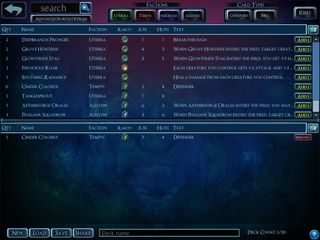
SolForge
SolForge is a free-to-play CCG currently on Steam Early Access, but has already gathered a small competitive following. This isn’t surprising, as it features multiple tournament modes built-in to accompany the standard versus mode. SolForge has been developed by the designers of Ascension and Magic: The Gathering, including the father of CCGs himself, Richard Garfield. It will eventually also feature a campaign mode.
How’s it different?
This is another card game that plays with the idea of positioning. SolForge breaks away from a lot of the tropes that Magic popularized. You each have five slots for creatures, most of which can’t move once they’ve been played. Each turn, every creature that can attack does so, trading damage with the creature directly opposite it. If there isn’t a creature to take the hit, they deal damage to the opponent’s health, which starts at 100. There are many creatures and cards that take advantage of being adjacent to other creatures or in a specific spot on the playing field.

Click the arrows in the top-right corner to enlarge.
The positioning is an interesting change, but damage is still dealt similarly to Hearthstone. The biggest change by far is how you draw and play cards in SolForge. Each turn, you draw five cards from your deck and have the option to play two of them, with no mana costs or restrictions, while the rest are discarded. As in scrolls, this makes mana and draw mechanics a non-issue when you are building decks, and instead forces you into making trade-offs. If you draw three cards you want to play, you need to decide which is the least valuable in your current situation and which might be more valuable to you later.
A card’s long-term value matters even more because of SolForge’s last major change. Every card in your deck has three levels of strength and all start at level one. When you choose to play a card, a leveled up version of it is put back into your deck for you to draw later. Because there’s no mana, your late-game cards are simply leveled up versions of the cards you’ve already played. There will never be a situation in SolForge when you draw all of your eight mana cards by turn three and can’t play anything—the game is designed to always scale into the late-game.
Being in Early Access still, SolForge’s graphics leave a lot to be desired. The card art itself is fantastic—each card changes as it levels up and it feels great to see your creatures look stronger as they gain power—but battle animations are a simple nudge forward into the opposing creature. Additionally, the UI needs a lot of work, as SolForge doesn’t quite have a clear visual language yet. If your opponent takes their turn quickly, it can be very easy for new players to miss what happened, and the game log is hidden in a menu. SolForge becomes easier to understand visually the more you play, but the UI and deckbuilding screens will be a bit frustrating until the game is finished.

Why should I play it?
SolForge is for people who are bored with what they know. It disrupts the CCG formula, and is being developed by the people who invented and refined that formula. Fair warning, though: it's definitely still in Early Access. The UI is unintuitive and the tutorial does a good job at teaching you the basics, but not much in the way of helping you understand why particular moves make sense. There is a complex CCG at SolForge’s core, but you might have to work a bit to get to grips with it.
SolForge is free-to-play and can be downloaded on Steam or its official site.
PC Gamer Newsletter
Sign up to get the best content of the week, and great gaming deals, as picked by the editors.
Most Popular



